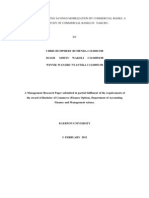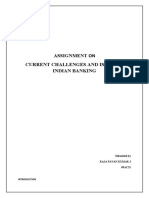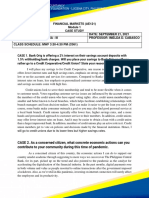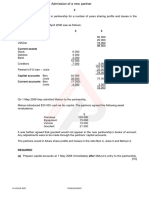BML 211 Wba Sept-Dec 2021
BML 211 Wba Sept-Dec 2021
Uploaded by
Kenya's FinestCopyright:
Available Formats
BML 211 Wba Sept-Dec 2021
BML 211 Wba Sept-Dec 2021
Uploaded by
Kenya's FinestOriginal Title
Copyright
Available Formats
Share this document
Did you find this document useful?
Is this content inappropriate?
Copyright:
Available Formats
BML 211 Wba Sept-Dec 2021
BML 211 Wba Sept-Dec 2021
Uploaded by
Kenya's FinestCopyright:
Available Formats
BML 211 MONEY AND BANKING (WBA)
SEPTEMBER-DECEMBER 2021
INSTRUCTIONS:
1. Use Times New Roman font type.
2. Font size 12
3. MINIMUM number of pages for CAT should be 10 pages and for WBA should
be 10 pages.
4. Clearly show the beginning of every new concept by using paragraphs.
5. Have a cover page that shows Name of University, students full name, student
Admission number, Unit title, Unit code, nature of assignment (CAT or WBA),
Lecturers name, Semester and Year (See Sample Cover Page Below-for use by
students)
6. Use APA style (latest edition) for reference & Citation
7. Use clear examples.
8. Use Ideas from the Notes presented & enhance your assignment by undertaking
a comprehensive research using material in the University Library, off campus
library material or any other reference material relevant to this course.
9. All Students must hand in a soft copy through Moodle online system
10. No assignment will be accepted after the due date.
MANAGEMENT UNIVERSITY OF AFRICA
BML 211 MONEY AND BANKING WBA SEPTEMBER-DECEMBER 2021 Page 1
STUDENT’S NAME: JOHN MALEMA
ADMISSION NUMBER: BDS/1/00900/3/2011
UNIT TITLE: MONEY AND BANKING
UNIT CODE : BML 211
WORK BASED ASSIGNMENT (WBA)
LECTURER’S NAME: ISABELLA SILE
SEMESTER: SEPTEMBER-DECEMBER 2021
WORK BASED ASSIGNMENT (WBA)
ANSWER ALL QUESTIONS (15 MARKS)
BML 211 MONEY AND BANKING WBA SEPTEMBER-DECEMBER 2021 Page 2
USE CLEAR EXAMPLES IN ALL POINTS PRESENTED
BANKING IN EAST AFRICA
The overall objective of the EAC Financial Sector Development and Regionalization
Project (FSDRP) is the establishment of a single market in financial services. In this
regard, the main objective of the EAC policies regarding the banking sector is to attain a
single market in banking services as a means to promote sustainable economic growth
in the Partner States and higher levels of financial inclusion.
The banking sector is playing a major role in propelling regional financial integration in
the EAC region by adopting a regional business model motivated by a range of factors
including client-demand and opportunities perceived along the regional trade
corridors.
The commercial banking industry in Kenya is the fourth largest in Sub Saharan Africa
after South Africa, Nigeria and Mauritius with 43 commercial banks and 2 mortgage
finance institutions. The Tanzania Banking system has 26 commercial banks whereas
there are 21 commercial banks in Uganda. The Rwanda banking system has 8
commercial banks, 1 development bank and 1 mortgage bank. The Burundi banking
industry is comprised of 7 commercial banks, 1 development bank and 1 housing fund.
Cross-border expansion of banking in the region started in the 2000’s with Kenyan
banks setting up in other EAC Partner States. As at the end of 2012, Kenyan banks had
set up a substantial branch network with 251 branches in the EAC (and also 31 branches
in South Sudan). A total of 11 multinational and Kenyan owned banks are performing
with cross-border banking business in the EAC.
Five (5) Kenyan banks with branches within the region include Kenya Commercial
Bank (KCB), Equity Bank, Fina Bank, Commercial Bank of Africa. Interest from banks
BML 211 MONEY AND BANKING WBA SEPTEMBER-DECEMBER 2021 Page 3
domiciled in other EAC Partner States in cross border expansion is increasing with
CRDB Tanzania setting up a branch in Burundi in 2012.
In all EAC countries, the commercial banks established national umbrella bodies,
known as Bankers’ Associations to promote member banks’ interests and endeavor a
reputable and professional banking sector. From the perspective of EAC
regionalization, an efficient and stable banking sector is a prerequisite for achieving
sustainable growth in EAC countries where the majority of financial intermediation
takes place through commercial banks.
With this regard, moving towards legal and regulatory harmonization against the
international standards known as the Basel Core Principles (BCPs) is critical to achieve
an effective functioning of a single market in banking services.
Required;
a) From the case study above, discuss five (5) reasons for the slow growth of
commercial banks in Africa (5 Marks)
First, the capacity for fiscal intervention – at least among developed economies – has been
underutilized. As former United States Deputy Secretary of the Treasury Frank Newman argued
in a recent book, Freedom from National Debt, a country’s capacity for fiscal intervention is
better assessed by examining its aggregate balance sheet than by the traditional method of
comparing its debt (a liability) to its GDP (a flow).
Reliance on the traditional method has resulted in missed opportunities, particularly given that
productive public-sector investment can more than pay for itself. Investments in infrastructure,
education, and technology help drive long-term growth. They increase competitiveness, facilitate
innovation, and boost private-sector returns, generating growth and employment. It does not take
BML 211 MONEY AND BANKING WBA SEPTEMBER-DECEMBER 2021 Page 4
a lot of growth to offset even substantial investment – especially given current low borrowing
costs.
Research by the International Monetary Fund has indicated that these fiscal multipliers – the
second factor overlooked by forecasters – vary with underlying economic conditions. In
economies with excess capacity (including human capital) and a high degree of structural
flexibility, the multipliers are greater than once thought.
In the Kenya, for instance, structural flexibility contributed to economic recovery and helped the
country adapt to long-term technological changes and global market forces. In Europe, by
contrast, structural change faces resistance. Fiscal stimulus in Europe may still be justified, but
structural rigidity will lower its impact on long-term growth. Europe’s fiscal interventions would
be easier to justify if they were accompanied by microeconomic reforms targeted at increasing
flexibility.
A third piece of the forecast puzzle is the disparity between the behavior of financial markets and
that of the real economy. Judged only by asset prices, one would have to conclude that growth is
booming. Obviously, it is not.
A major contributor to this divergence has been ultra-loose monetary policy, which, by flooding
financial markets with liquidity, was supposed to boost growth. But it remains unclear whether
elevated asset prices are supporting aggregate demand or mainly shifting the distribution of
wealth. It is equally unclear what will happen to asset prices when monetary assistance is
withdrawn.
BML 211 MONEY AND BANKING WBA SEPTEMBER-DECEMBER 2021 Page 5
A fourth factor is the quality of government. In recent years, there has been no shortage of
examples of governments abusing their powers to favor the ruling elite, their supporters, and a
variety of special interests, with detrimental effects on regulation, public investment, the delivery
of services, and growth. It is critically important that public services, public investment, and
public policy are well managed. Countries that attract and motivate skilled public managers
outperform their peers.
Finally, and most important, the magnitude and duration of the drop in aggregate demand has
been greater than expected, partly because employment and median incomes have been lagging
behind growth. This phenomenon preceded the crisis, and high levels of household debt have
exacerbated its impact in the aftermath. The stagnation of incomes in the bottom 75% of the
distribution presents an especially large challenge, because it depresses consumption,
undermines social cohesion (and thus political stability and effectiveness), and decreases
intergenerational mobility – especially where public education is poor.
b) The case study explains that the commercial banks established national umbrella
bodies, known as Bankers’ Associations. Discuss five (5) benefits of banker’s
association (5 Marks)
Members also benefit from regular updates and bulletins concerning compliance issues
including calendars for final rulings, as well as group discussions about how to
implement strategies to be compliant with all current federal rulings.
Associations offer extensive training in other banking areas, often breaking such training
down by standard job description so that members may best take advantage of training
BML 211 MONEY AND BANKING WBA SEPTEMBER-DECEMBER 2021 Page 6
that is job-specific to them personally. This saves time and money for the bank and for
the busy executive individually.
Not to be overlooked is the advantage of having a platform for advocacy. Banking
associations understand the needs of the banking industry, and united groups can effect
real and lasting change in legislation that leads to economic growth.
Generous Benefit Packages
Most bankers enjoy comprehensive benefits packages. Large banks typically offer medical,
dental and vision insurance to its bankers and their families. Bankers have access to a
retirement plan, life insurance, disability insurance and flexible spending accounts for health
care and child care. Other commonly offered bank job benefits include paid time off, free
financial services, adoption assistance and fitness programs.
Fulfilling Career
Banking is a fulfilling career choice for individuals who want to help the public. Bankers
play an essential role in society by protecting, investing and lending money. Many play a
direct role in helping clients' make some of the most important decisions of their lives,
such as saving for college, purchasing homes and planning for their business and
retirement needs. Bankers also have opportunities to fulfill their civic desires
c) Explain five (5) strategies that banks in East Africa can use in order to develop
rapidly
(5 Marks)
BML 211 MONEY AND BANKING WBA SEPTEMBER-DECEMBER 2021 Page 7
Community Marketing
Banks range in size and capabilities, so banking business development will vary from market to
market. Small banks may only have one or two branch offices whereas large commercial banks
may have thousands of branches across the nation. Regardless of the size of the bank, each
branch needs to tailor local marketing strategies to serve the immediate community. Consumers
bank in a place where they feel safe and comfortable. This means tellers and account
representatives who speak English as well as any prominent language in the community. By
having branch managers look at the local community needs, the bank can attract a larger
percentage of the target market.
Product Bundling
A successful strategy employed by all banks is product bundling, such as offering a free
checking account for those who open a savings account, according to Bank Systems &
Technology. Because this has become common practice, successful strategies implement creative
bundling solutions. An automatic home line of credit with a mortgage refinance might be a
solution when interest rates are low or the community has a large percentage of consumers
looking to consolidate debt.
Pre-Approved Products
Consumers are more likely to say yes to something when they already know they are approved
for it, including pre-approved products that pop up on a computer screen, according to The
Financial Brand. Banks can review existing accounts to determine positive banking and credit
BML 211 MONEY AND BANKING WBA SEPTEMBER-DECEMBER 2021 Page 8
trends in customers. Those identified with positive trends and credit history are sent "pre-
approval" letters for credit cards, lines of credit or mortgages.
Teller Referrals
Bank tellers interact with the majority of the bank clientele. Tellers perform the day-to-day
transactions, such as cashing checks, making deposits or transferring money. Successful banks
consistently train tellers to look for opportunities to cross-sell bank products and refer customers
to the right person. A teller may see a regular customer cash a dividend check and refer the
person to the investment specialist. The teller may see a high savings balance and suggest a
higher-earning time certificate. Smart banks reward top referring tellers to entice them to take the
time to suggest a new product or service.
Premier Services
Premier services are designed to attract high net worth bank clientele; this is an effective strategy
to increase bank deposits. High net worth clients often have different needs as well as
expectations. By offering a select set of private bankers to personally handle all transactions and
account reviews, client trust increases. Service is often better with private bankers able to focus
on finding the best solutions to fit complete financial scenarios.
BML 211 MONEY AND BANKING WBA SEPTEMBER-DECEMBER 2021 Page 9
BML 211 MONEY AND BANKING WBA SEPTEMBER-DECEMBER 2021 Page 10
You might also like
- Impact of Strategic Planning On Bank's Performance in NigeriaDocument44 pagesImpact of Strategic Planning On Bank's Performance in NigeriaJimoh KayodeNo ratings yet
- Homework 4 SolDocument4 pagesHomework 4 SolLin FengNo ratings yet
- Dhaka International University: Course AmeDocument12 pagesDhaka International University: Course Amesom tiktok channelNo ratings yet
- Group 5 DBA 401 AssignmentDocument13 pagesGroup 5 DBA 401 AssignmentsharonNo ratings yet
- Factors Influencing Savings Mobilization by Commercial BanksDocument81 pagesFactors Influencing Savings Mobilization by Commercial BanksNicholas Gowon100% (7)
- Role of Commercial Banks in Development Financing in BangladeshDocument31 pagesRole of Commercial Banks in Development Financing in Bangladeshfind4mohsinNo ratings yet
- The Financial Sector and The Role of Banks in Economic DevelopmentDocument6 pagesThe Financial Sector and The Role of Banks in Economic Developmentpravas ranjan beheraNo ratings yet
- Bank Capital Adequacy Ratio and Bank Performance in Vietnam: A Simultaneous Equations FrameworkDocument19 pagesBank Capital Adequacy Ratio and Bank Performance in Vietnam: A Simultaneous Equations Frameworknguyendat160303No ratings yet
- Chapter I - IntroductionDocument10 pagesChapter I - IntroductionRekha Suresh M PNo ratings yet
- BML 211 Cat Sept-Dec 2021Document7 pagesBML 211 Cat Sept-Dec 2021Kenya's FinestNo ratings yet
- Bank CreditsDocument11 pagesBank CreditsAlexander DeckerNo ratings yet
- Pakistan Banking SectorDocument100 pagesPakistan Banking SectorFaraz50% (2)
- Why Banks FailDocument12 pagesWhy Banks FailpatrickNo ratings yet
- Rbi PDFDocument28 pagesRbi PDFRAGHUBALAN DURAIRAJUNo ratings yet
- Aishat Project Chapter 1-5Document78 pagesAishat Project Chapter 1-5Emeka MichealNo ratings yet
- Dissertation On Commercial BanksDocument4 pagesDissertation On Commercial BanksNeedHelpWithPaperSingapore100% (1)
- Banking Challenges 09AC31 PsgimDocument10 pagesBanking Challenges 09AC31 Psgimscribd09ac31No ratings yet
- Tutorial Sheet 2Document7 pagesTutorial Sheet 2kinikinayyNo ratings yet
- Contemporary Issues... Money, Capital Market...Document14 pagesContemporary Issues... Money, Capital Market...Hoyo VerseNo ratings yet
- Credit Risk Management in BanksDocument53 pagesCredit Risk Management in Banksrahulhaldankar100% (1)
- Asset Quality As A Determinant of Commercial Banks Financial Performance in KenyaDocument12 pagesAsset Quality As A Determinant of Commercial Banks Financial Performance in KenyaAsegid GetachewNo ratings yet
- Interest Rate Spread On Bank Profitability: The Case of Ghanaian BanksDocument12 pagesInterest Rate Spread On Bank Profitability: The Case of Ghanaian BanksKiller BrothersNo ratings yet
- Banking Sector Globalization and Bank PerformanceDocument8 pagesBanking Sector Globalization and Bank PerformanceMaria AwadNo ratings yet
- Credit MarketDocument64 pagesCredit MarketNiket DattaniNo ratings yet
- On Financial Inclusion A Must For Growth of Indian Economy: Summer Training ReportDocument44 pagesOn Financial Inclusion A Must For Growth of Indian Economy: Summer Training ReportMahey HarishNo ratings yet
- Financial Literacy: An Essential Tool To Regain Confidence in The Financial Services IndustryDocument77 pagesFinancial Literacy: An Essential Tool To Regain Confidence in The Financial Services IndustryStefan LiaNo ratings yet
- Bank CreditDocument49 pagesBank CreditJimoh KayodeNo ratings yet
- Bank Term PaperDocument8 pagesBank Term Papercvqvxrwgf100% (1)
- Basan C061 Prelims CasestudyDocument5 pagesBasan C061 Prelims Casestudyliberace cabreraNo ratings yet
- Money MattersDocument8 pagesMoney MattersNitin JindalNo ratings yet
- Thesis On Banking RegulationDocument7 pagesThesis On Banking Regulationlauramartinmanchester100% (2)
- Research Paper About BanksDocument7 pagesResearch Paper About BankscwzobjbkfNo ratings yet
- Financial System AssignementDocument15 pagesFinancial System Assignementtamasgeentashalee12No ratings yet
- Mikias PaperDocument60 pagesMikias PaperMeadot MikiasNo ratings yet
- Banking Sector Stability, Efficiency, and Outreach in Kenya: This Draft: August 2009 Executive SummaryDocument36 pagesBanking Sector Stability, Efficiency, and Outreach in Kenya: This Draft: August 2009 Executive SummaryrajrudrapaaNo ratings yet
- Banking Sector in 2007 in The Middle EastDocument21 pagesBanking Sector in 2007 in The Middle EastAbdul_muqtaderNo ratings yet
- Talent Ngombe ProposalDocument14 pagesTalent Ngombe ProposalSamson NdhlovuNo ratings yet
- Role of Commercial Banks in Development PDFDocument31 pagesRole of Commercial Banks in Development PDFRahut HridayNo ratings yet
- Deposits and Mobilisation With Reference To Nationalised BanksDocument26 pagesDeposits and Mobilisation With Reference To Nationalised BanksKofi Mc SharpNo ratings yet
- Final ProposalDocument12 pagesFinal ProposalRakshya NeupaneNo ratings yet
- Recent Trends in BankingDocument8 pagesRecent Trends in BankingNeha bansalNo ratings yet
- Abstract The Objective of This Study Was To Examine The Factors Influence Credit Rationing by Commercial Banks in KenyaDocument8 pagesAbstract The Objective of This Study Was To Examine The Factors Influence Credit Rationing by Commercial Banks in KenyaMrxNo ratings yet
- Non Performing Loans Perception of Somali BankersDocument27 pagesNon Performing Loans Perception of Somali BankersIJARP PublicationsNo ratings yet
- Challenges Facing Implimentation of CRB Regulations in Kenya Commercial Banks in Kakamega TownshipDocument10 pagesChallenges Facing Implimentation of CRB Regulations in Kenya Commercial Banks in Kakamega TownshipAlexander DeckerNo ratings yet
- Universiti Utara Malaysia: Corporate Financial Management (BWFF5013)Document14 pagesUniversiti Utara Malaysia: Corporate Financial Management (BWFF5013)orient4No ratings yet
- Dissert Chapter OneDocument78 pagesDissert Chapter OneAmidu MansarayNo ratings yet
- Chapter 3 The Role of Financial Institutions in The Economic Development of Malawi: Commercial Banks PerspectiveDocument27 pagesChapter 3 The Role of Financial Institutions in The Economic Development of Malawi: Commercial Banks PerspectiveBasilio MaliwangaNo ratings yet
- Impact of Loan by National Commercial Bank On Amwal International Investment CompanyDocument23 pagesImpact of Loan by National Commercial Bank On Amwal International Investment CompanyJo Anne MirandaNo ratings yet
- H R Khan: Financial Inclusion and Financial Stability: Are They Two Sides of The Same Coin?Document12 pagesH R Khan: Financial Inclusion and Financial Stability: Are They Two Sides of The Same Coin?Yasmine MagdiNo ratings yet
- Bank ThesisDocument6 pagesBank Thesismariestarsnorthlasvegas100% (1)
- EconomicsDocument40 pagesEconomicsTola BayisaNo ratings yet
- Classens, K. and Van Horen, N. (2012) Foreign Banks: Trends, Impact and Financial Stability', IMF Working Paper, International Monetary FundDocument4 pagesClassens, K. and Van Horen, N. (2012) Foreign Banks: Trends, Impact and Financial Stability', IMF Working Paper, International Monetary FundMinh VănNo ratings yet
- Visit Report Financial Institution Other ThanbankDocument8 pagesVisit Report Financial Institution Other ThanbankBhavik ChaudhariNo ratings yet
- Risk Management in Banking Sector Main01Document42 pagesRisk Management in Banking Sector Main01Azim Samnani0% (1)
- 528201450239PMPaper Banking Structure For India 2014Document19 pages528201450239PMPaper Banking Structure For India 2014Gaurav RawatNo ratings yet
- Unlocking SME Finance Through Market Based DebtDocument103 pagesUnlocking SME Finance Through Market Based DebtFif SmithNo ratings yet
- Research Paper Topics in Banking and FinanceDocument7 pagesResearch Paper Topics in Banking and Finances0l1nawymym3100% (1)
- Fi Case Study 2 NewDocument9 pagesFi Case Study 2 NewKrutik ShahNo ratings yet
- Banking in Africa: financing transformation amid uncertaintyFrom EverandBanking in Africa: financing transformation amid uncertaintyNo ratings yet
- Banking in Africa: Delivering on Financial Inclusion, Supporting Financial StabilityFrom EverandBanking in Africa: Delivering on Financial Inclusion, Supporting Financial StabilityNo ratings yet
- BML 211 Cat Sept-Dec 2021Document7 pagesBML 211 Cat Sept-Dec 2021Kenya's FinestNo ratings yet
- BML 202/ BCM 126 - Quantitative Techniques September-December, 2021 InstructionsDocument6 pagesBML 202/ BCM 126 - Quantitative Techniques September-December, 2021 InstructionsKenya's FinestNo ratings yet
- BML 202/ BCM 126 - Quantitative Techniques September-December, 2021 InstructionsDocument6 pagesBML 202/ BCM 126 - Quantitative Techniques September-December, 2021 InstructionsKenya's FinestNo ratings yet
- BML 203 Wba September December 2021Document9 pagesBML 203 Wba September December 2021Kenya's FinestNo ratings yet
- BML 200 Sep - Dec 2021 WbaDocument6 pagesBML 200 Sep - Dec 2021 WbaKenya's FinestNo ratings yet
- BML 200 Sep - Dec 2021 CatDocument3 pagesBML 200 Sep - Dec 2021 CatKenya's FinestNo ratings yet
- Study Plan Introduction of My BackgroundDocument2 pagesStudy Plan Introduction of My BackgroundDiandra DwitavianyNo ratings yet
- Cement and Steel IndustryDocument16 pagesCement and Steel IndustryGanesh BankarNo ratings yet
- California City Manager CompensationDocument24 pagesCalifornia City Manager CompensationBill Gram-Reefer0% (1)
- Quiz3 A102Document4 pagesQuiz3 A102Wan Norhayati Wan Ahmad100% (1)
- Executive SummaryDocument1 pageExecutive SummaryRezwana Newaz SuroviNo ratings yet
- Problem StatementDocument4 pagesProblem StatementWaqas Khan75% (4)
- Rose PetalDocument35 pagesRose PetalHussainMudassarNo ratings yet
- All Our Futures: Creativity, Culture and EducationDocument243 pagesAll Our Futures: Creativity, Culture and EducationJoaquín Vicente Ramos RodríguezNo ratings yet
- Need of Mining Industry A SWOT AnalysisDocument5 pagesNeed of Mining Industry A SWOT AnalysisPravesh PangeniNo ratings yet
- Local PANGASINAN ATIDocument3 pagesLocal PANGASINAN ATIJulia MaquirangNo ratings yet
- The Capital Budgeting Decision: Mcgraw-Hill/IrwinDocument48 pagesThe Capital Budgeting Decision: Mcgraw-Hill/IrwinMaybelle BernalNo ratings yet
- En 20120404Document24 pagesEn 20120404Hai Hoang ThanhNo ratings yet
- CGSR 10 MarksDocument16 pagesCGSR 10 Markssurya rathishNo ratings yet
- Chapter 1 - Introduction To EntrepreneurshipDocument21 pagesChapter 1 - Introduction To EntrepreneurshipMINNo ratings yet
- Chapter 7 Decentralization and Transfer PricingDocument34 pagesChapter 7 Decentralization and Transfer Pricingtamirat tadeseNo ratings yet
- Math-Based Quiz Questions Worked OutDocument130 pagesMath-Based Quiz Questions Worked OutJ MNo ratings yet
- Rwanda's DevelopmentDocument6 pagesRwanda's DevelopmentNehir TükenmezNo ratings yet
- Public Enterprise in EthiopiaDocument14 pagesPublic Enterprise in EthiopiaAmbachew Motbaynor100% (22)
- Atkinson, Anthony - Multidimensional Deprivation. Contrasting Social Welfare and Counting ApproachesDocument15 pagesAtkinson, Anthony - Multidimensional Deprivation. Contrasting Social Welfare and Counting ApproachesNincen Figueroa UrquizaNo ratings yet
- Page 1 of 5: Customer Care: 1860 120 7777Document5 pagesPage 1 of 5: Customer Care: 1860 120 7777SundarNo ratings yet
- Erratum Cpa Reviewer 2Document1 pageErratum Cpa Reviewer 2Monina Ninyah Aguiling Manulat100% (1)
- IMPACT OF AI (Artificial Intelligence) ON EMPLOYMENT: Nagarjuna V 1NH19MCA40 DR R.SrikanthDocument24 pagesIMPACT OF AI (Artificial Intelligence) ON EMPLOYMENT: Nagarjuna V 1NH19MCA40 DR R.SrikanthNagarjuna VNo ratings yet
- A2 Financial Workbook 2025 - 241004 - 201112Document1 pageA2 Financial Workbook 2025 - 241004 - 201112imehdisarfarazNo ratings yet
- Application For MembershipDocument3 pagesApplication For MembershipLone XRangerNo ratings yet
- Hadian 2020Document20 pagesHadian 2020valentina raniNo ratings yet
- Why Do Nations TradeDocument10 pagesWhy Do Nations TradeAsmara khizerNo ratings yet
- Milma Introduction 1Document22 pagesMilma Introduction 1Jithin joseNo ratings yet
- Applied Consulting Project Proposal On Gowling WLGDocument14 pagesApplied Consulting Project Proposal On Gowling WLGShah Md. Jakaria AbirNo ratings yet
- Market SegmentationDocument14 pagesMarket SegmentationFarida MandviwalaNo ratings yet






























































































